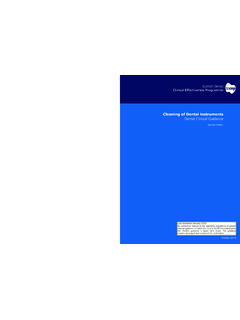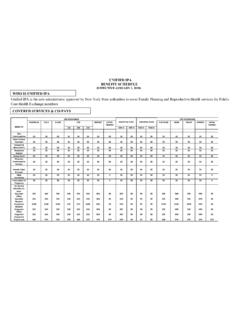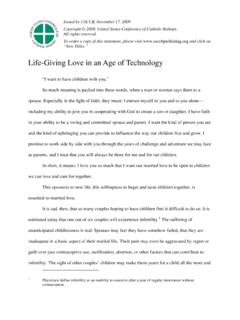Transcription of CULTURE MEDIA AND CULTIVATION OF BACTERIA
1 CULTURE MEDIA 1 CULTURE MEDIA AND CULTIVATION OF BACTERIAThe study of microorganisms requires techniques for isolating cells from natural sources andgrowing them in the laboratory on synthetic MEDIA . Thus, development of synthetic CULTURE mediaand CULTURE techniques have played important roles in the advancement of this field. Microbiologistsuse bacterial CULTURE MEDIA for many purposes and applications. MEDIA are used to isolate andidentify BACTERIA , reveal their metabolic properties, and allow long-term storage of pure cultures. Taxonomic descriptions of BACTERIA commonly include information about their cultural requirements;species that are poorly characterized are frequently those most difficult to CULTURE under laboratoryconditions. Indeed, Koch s second postulate requires culturing of a suspected pathogen in pureform. In this laboratory exercise you will learn about composition and types of CULTURE MEDIA andhow different types of MEDIA can be used to study the properties of BACTERIA .
2 You will be asked todrawn upon this knowledge frequently in future laboratory nutritional requirementsOur ability to study different types of BACTERIA ultimately relies upon knowing their nutritionalrequirements. The BACTERIA with which we are most familiar are generalists (which are able to usea wide range of nutrients) and/or nutrients that are commonly available. Some BACTERIA cansynthesize all of their growth requirements from common mineral nutrients and simplecarbohydrates. However, some BACTERIA are classified as auxotrophs because, even given acarbohydrate carbon source, they cannot synthesis one or more organic molecules required for theirgrowth these molecules must be also provided in growth MEDIA . However, if a sample swabbedfrom your mouth were inoculated on a plate of common CULTURE medium, only a small percentageof the hundreds of different BACTERIA will grow and form colonies. This is because most BACTERIA arefastidious, meaning that they have very specific and/or complex nutritional requirements.
3 Thesespecies do not grow because they cannot use one or more nutrients in the form provided in themedium ( , they might require H2S rather than SO4 as a sulfur source), have requirements for veryspecific types of nutrients (such as certain complex organic molecules), and/or require unusualgrowth conditions (such as growth in living cells or at high temperature or pressure). We presentlyknow very little about many of these BACTERIA because we do not know how to grow them underartificial laboratory factor that greatly influences bacterial growth is their oxygen requirements. Clearly, thetechniques used to CULTURE and study an obligate anaerobe must be different from those used whenculturing an aerobe. Thus, in the final section of this lab exercise you will study bacterial oxygenrequirements and methods used to CULTURE MEDIA 2 Summary of exercise1. You will learn about components of bacterial CULTURE MEDIA and how MEDIA are classified basedupon composition and other You will prepare a complex-type medium from a preformulated mixture and use it to You will prepare defined MEDIA that will be used to study carbon and nitrogen requirements You will study the use of a medium classified as both selective and You will use two techniques to CULTURE anaerobic of CULTURE mediaMedia are classified on the basis of composition or application.
4 Often, a particular medium mayfall into two or more categories, which leads to some confusion among students. Thus, for example,a "defined" medium might be also classified as "selective" or "differential" depending upon itsspecific properties and application in a particular situation. The four principal types of CULTURE mediaare described MEDIA . Pasteur, Koch, and Tyndall typically prepared MEDIA by boiling animal or plantmaterials to extract nutritive molecules. Today, many modern complex MEDIA (such as Tryptic SoyAgar) contain extracts of beef (peptone), milk (tryptone), soybean meal (soytone), or yeast. Theprotein in these extracts are broken down into small peptides and amino acids. Although the specificamount of these molecules is not precisely determined, their wide assortment allows complex mediato support a wide range of bacterial types. Defined MEDIA . Defined MEDIA are formulated from pure substances at predeterminedconcentrations.
5 Thus, unlike complex MEDIA , the exact chemical composition of defined MEDIA isknown precisely. Because the composition is precisely established, defined MEDIA are often usedto determine the nutritional requirements of bacterial MEDIA . Complex or defined MEDIA will also be classified as selective if they support thegrowth of only certain types of BACTERIA . MEDIA can be made selective through the addition ofsubstances that enhance or inhibit the growth of particular types of BACTERIA . MEDIA have beendeveloped that are selective for an astonishing diversity of BACTERIA , and we will be using many ofthese MEDIA throughout the semester. DIFFERENTIAL MEDIA . Any of the above types of MEDIA might also be formulated as adifferential medium. A differential medium reveals specific metabolic or metabolic characteristicsof BACTERIA grown on it. Differential MEDIA are among the most powerful tools available to amicrobiologist, revealing a wide range of information about an organism very quickly.
6 Some mediaare both selective and differential. For example, the medium called MacConkey Agar is selectivefor gram-negative BACTERIA and will indicate whether BACTERIA can ferment MEDIA 3I. PREPARING 'COMPLEX TYPE' CULTURE MEDIAM icrobiologists traditionally mixed MEDIA by combining the individual components listed fora recipe. For a complicated medium, this could be a very time-consuming process. Today, mostmedia are available commercially in premixed and dehydrated form. The MEDIA are prepared bysimply dissolving the powder in water, sterilizing the solution, and then dispensing it into culturevessels. Two of the largest suppliers are BBL and Difco laboratories. Difco publishes a book(cleverly named the "Difco Manual") that lists the application, composition, history of developmentand other useful information for each medium it supplies. Copies of the 9th edition of the DifcoManual are in the laboratory, and you are encouraged to peruse one at your convenience during thelaboratory objective in this exercise is to gain experience in preparing bacterial CULTURE MEDIA .
7 Themedium that you will prepare is called Tryptic Soy Broth (TSB) which is designed to support thegrowth of a wide range of bacterial types. The composition of this medium is given below:TRYPTIC SOY BROTH (TSB) Component g/L mediumTryptone .. ))) is a "complex" type medium. How can you tell? To prepare 1 liter of Tryptic Soy Broth(TSB), g of the medium would be dissolved in 1 liter of H2O and then autoclaved. This wouldyield a liquid (broth) CULTURE mediaOften, CULTURE MEDIA is prepared in a solid form, such as that in the slants and petri plates whichyou used previously this semester. Generally, CULTURE MEDIA is solidified with the addition ofAGAR, a purified carbohydrate obtained from a marine seaweed. Agar is the most widely usedsolidifying agent for two reasons: 1) very few BACTERIA can metabolize it, and thus, it does not serveas a nutrient source, and 2) it has the unusual property of melting at 100EC but not resolidifying untilthe temperature decreases to 45EC.
8 Thus, depending upon its previous temperature history, mediacontaining agar can exist as either a liquid or solid at a temperature between 45E - 60EC . In futurelaboratory exercises we will take advantage of this property. CULTURE MEDIA 4 Supplies1 empty 250 ml flaskautoclave tape1 empty 16mm test tubes (red cap)TSB (clear cap)4 sterile petri plates1 5 ml pipetagar (white cap)ProcedureIn this part of the lab exercise you will prepare and sterilize Tryptic Soy Broth (TSB) andsolid Tryptic Soy Agar (TSA) CULTURE MEDIA . We will begin by preparing 100 ml of TSBwhich is prepared at a ratio of 3 g of the dehydrated powder per 100 ml of Preparing TSB broth medium1. Transfer the dehydrated TSB medium to a 250 ml flask2. Add 100 ml of deionized water and swirl until all of the powder is completely To emphasize the importance of MEDIA sterilization, pipet 5 ml of TSB from the bottle intoa 16mm test tube. Label and place it in your drawer. 4. Examine the appearance of the medium next time you come to lab, and then dispose of Preparing solid medium (TSA)You will now add agar to the remaining 95 ml of TSB to produce "Tryptic Soy Agar.
9 Likemost solid MEDIA TSA has an agar concentration of (w/v), which is g per 95 ml. 1. Transfer the agar to the TSB Cover the mouth of the flask with foil, and label it on the autoclave tape as "TSA" withyour name and Place the flask in the tray to be After autoclaving, the flasks will be placed in a 50OC water bath to Pouring solid medium into petri plates1. Label the base of 4 petri plates with your name and Remove your flask from the water bath, dry the outside with a paper towel, and swirl themedium to mix the dissolved agar completely. 3. Return to your work station. You will need to work quickly but carefully now because themedium will begin to solidify when the temperature drops to Remove the foil from the flask and hold the flask at an angle at all times to minimize thechance for Sequentially, lift the lid of each plate just enough to allow the medium to be poured in. Add enough to each plate to cover the Let the medium solidify for about 15 minutes before moving the plates.
10 7. Save the solidified plates in your drawer. You should use two of them to restreak yoursemester unknown to check for USING DEFINED MEDIA TO STUDY NUTRITIONALC ulture MEDIA 5 REQUIREMENTSMany species of BACTERIA are identical in appearance and can only be distinguished by theirbiochemical or metabolic properties. One such property is their nutritional requirements. While allbacteria require similar essential mineral nutrients, such as carbon and nitrogen, species must obtainthese nutrients in particular chemical forms. For example, some species can obtain nitrogen fromnitrite (NO2) but not ammonia (NH3), vice versa, either, or neither. DEFINED MEDIA , which containspecific quantities of known substances are commonly used to determine the specific nutritionalrequirements and capabilities of BACTERIA . Since defined MEDIA typically provide the minimalrequired source of nutrients, even generalist BACTERIA may grow more slowly than on complex typeof this exercise, you will prepare a series of defined MEDIA that contain different nitrogensources.








